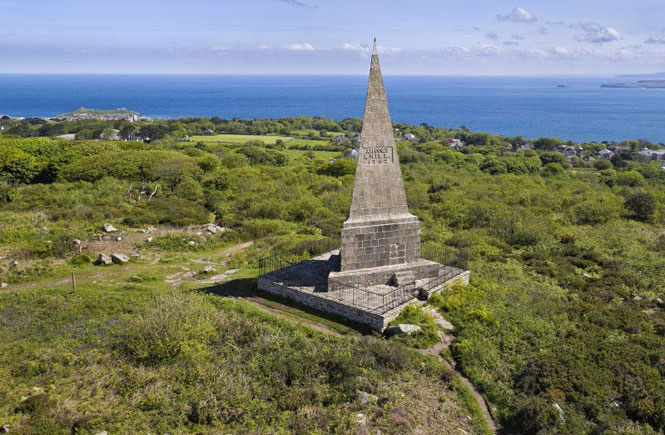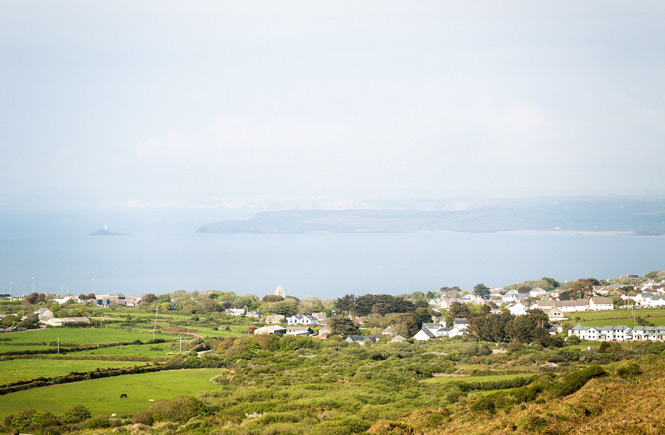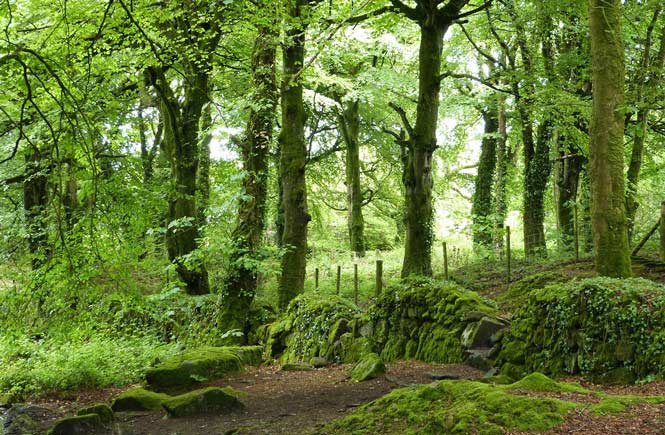The Steeple Woodland Nature Reserve is a 40 acre public open space around Knill’s Monument – a 50 foot high granite pyramid – overlooking St Ives. The monument is a prominent landmark in the St Ives area and can be seen from as far away as Camborne.

With glorious sweeping views of St Ives Bay, the North coast and West Cornwall, mature woodland, regenerating young woodland and heathland and links to St Ives’ past, the Steeple Woodland Nature Reserve is a great place to visit.
The Steeple Woodland Nature Reserve can be accessed at various points, but for those not familiar with the area it’s best to keep to the main ones. If catching the bus it’s a 5 minute ride from St Ives’s main bus station, The Malakoff and ask for the Cornish Arms. The bus trip itself will give you lovely views over St Ives Bay for a short time before you reach your stop, you’ll then see the pub slightly up the hill on the right-hand side of the main road. If you prefer to walk it’s about a mile to the Cornish Arms from St Ives town centre along the main road to Carbis Bay (A3074), the pub will be on your right. Take the narrow road at the side of the pub – Steeple Lane – and follow this for about half a mile. You’ll be walking up hill which will become steeper as you go. Eventually the road levels out and you’ll be able to see the Steeple to your left.
If you are driving follow the same directions – turning up Steeple Lane next to the Cornish Arms pub and continuing up this narrow road until you reach the level section at the top which has areas to park to the right and left. Before continuing up the path to the Steeple there is an information display board which tells you a bit about the area.
Hopefully you’ll be visiting in good weather and if so you’ll be treated to spectacular views from this vantage point. Looking East you can see The Island (St Ives Head) as well as St Ives Bay, Godrevy Lighthouse, the towans which border the Eastern edge of the bay, the entrance to Hayle Estuary and along the North coast. The china clay tips near St Austell can also be glimpsed in clear conditions. To the West, moorland and hills stretch away towards Zennor and Land’s End.

Once you’ve enjoyed the stunning views – and it may be difficult to drag yourself away! – start heading back down the path you came up on but continuing straight down with the bay in front of you. Watch your step as you go as this path is fairly rough in places with the odd boulder and dip. To your left you’ll be able to see some chunks of hand-cut granite strewn around in the undergrowth. Granite from around this area was used to build many houses in Downalong St Ives (the older fishermen’s quarter). About halfway down this path you’ll pass under a large Turkey oak tree and climb through a gap in an old granite wall, continue down a little further and you’ll start seeing young trees on both sides of the path.
You’ll then meet another path and here you turn right. As you start along this path look to your right where you’ll see a gully which fills with water, this was part of a reservoir system which served the mining industry in the 19th century. Continue straight ahead and if you look to your left you’ll see a open clearing, this was a reservoir which the water from the gully drained into, it is lined with china clay and in wet weather can fill up to about 9 inches deep. The group which manage the reserve decided to keep it clear and each year hold their open day there.
As you continue on this path the landscape opens up and you can really see the ongoing work that has gone into creating the Nature Reserve. Thousands of young trees, mostly still with their shelters, cover the land on each side of the path, these were planted over the last 15 years or so by community groups, school children, volunteers etc. You’ll eventually reach a big rhododendron thicket which borders the Nature Reserve and if you look to your left you’ll see another interesting feature – a large granite boundary stone with an ‘F’ on one side and ‘C’ on the other. Bear to left on this path until you reach the bottom, then take the path to the left.
This path marking the eastern border of the Nature Reserve is nice and level, although sometimes a little muddy. You’ll find yourself walking between trees, such as blackthorn which are a common native tree found all over the area, and others such as rowan which have been planted by volunteers. Keep going until you come to a fairly wide path leading back up the hill to your left. As you turn left there is a granite stone wall to your left, one of the many built around the mineshafts left over from the mining activities, over the years these walls have become havens for wildlife.
As you continue along this path bear right and you’ll find yourself walking between fairly tall trees and more granite mineshaft walls. The narrow path continues through this lower section of the Nature Reserve which is gradually transforming into woodland, the first trees planted by volunteers are in this area. After a few minutes’ gradual climb you’ll find yourself on a well established path and will see a wooden gate to your right with the Steeple Woodland notice board attached to it.
You could end your walk here if you wish, those who came on foot simply turn right and head back down Steeple Lane towards St Ives Road. If you’ve driven, turn left and walk up the hill for a couple of minutes to rediscover your car.

Or… you could complete your visit to the Nature Reserve with a walk through the beautiful mature woodland. Simply cross the road from the wooden gate where you can see a small track leading into the woods (ignore the wooden gate opposite, this is private land and densely covered in rhododendron). The path leads over a low wall and you’ll then find yourself under a canopy of green leaves with the woodland stretching before you. If you bear to the left you can make your way up the slope and through a gate which leads back to the parking area, or if you’re feeling more adventurous you could explore the woods further eventually making your way out via the top gate. The woods aren’t very extensive so you shouldn’t get lost. If you decide to bear right into the woods you’ll find ancient mineworkings (fenced off!) and little rivulets trickling through.
Watch your step on all the paths, the Nature Reserve is intended to remain a wild area and as such none of the paths have been treated.
You could of course make even more of a day of your trip to the Nature Reserve. There are plenty more areas to explore and the many paths lead to little glades and clearings to be discovered. There is so much to see including plenty of wildlife, look out for birds, butterflies, dragonflies and rabbits.
We hope you enjoy your visit to the Nature Reserve, if you fancy a change of scenery from the hustle and bustle of St Ives town centre and the beaches, and want to immerse yourself in nature this could be the perfect visit for you.
Find out more about Steeple woods and its history on our blog.
View all our Carbis Bay cottages >